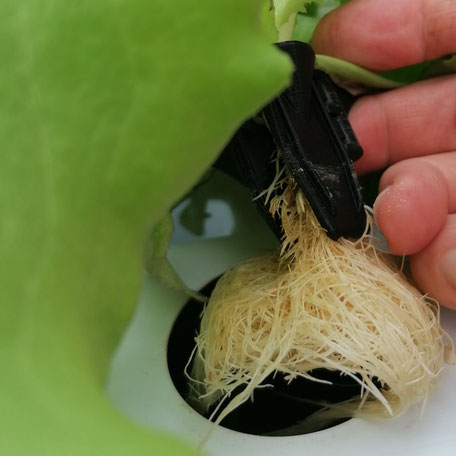For English version, please scroll down
Luftwurzeln sind ein faszinierendes Phänomen in der Pflanzenwelt, das oft mit epiphytischen Pflanzen wie Orchideen oder Bromelien in Verbindung gebracht wird. Aber was ist mit Luftwurzeln in der Hydroponik? Wir werfen einen genaueren Blick darauf und klären einige Missverständnisse.
Was sind Luftwurzeln?
Luftwurzeln sind spezialisierte Wurzeln, die bestimmte Pflanzenarten entwickeln, um zusätzliche Feuchtigkeit und Nährstoffe aus der Umgebungsluft aufzunehmen. Diese Wurzeln können in der Regel außerhalb des Bodens oder eines Wurzelmediums wachsen und dienen dazu, die Pflanze besser an ihre Umgebung anzupassen.
Luftwurzeln in der Hydroponik
In der Hydroponik entwickeln Pflanzen keine spezialisierten Luftwurzeln wie in natürlichen Umgebungen. Stattdessen bilden sie normale Wurzeln, die in der Luft hängen. Die in der Hydroponik üblichen Pflanzenarten sind nicht in der Lage spezielle Luftwurzeln zu bilden.
Luftwurzeln vs. Wurzeln in der Luft
Es ist wichtig zu verstehen, dass der Begriff "Luftwurzeln" in der Hydroponik oft einfach verwendet wird, um zu beschreiben, dass die Wurzeln einer Pflanze in der Luft hängen, anstatt im Boden zu wachsen. Diese Wurzeln haben die gleiche Struktur wie Wurzeln, die im Boden wachsen, und dienen demselben Zweck: die Pflanze mit Wasser, Nährstoffen und Sauerstoff zu versorgen.
Fazit
Luftwurzeln in der Hydroponik sind kein eigenständiges Phänomen wie bei einigen epiphytischen Pflanzen in natürlichen Umgebungen. Vielmehr bezieht sich der Begriff "Luftwurzeln" einfach darauf, dass die Wurzeln der Pflanzen in der Luft hängen, anstatt in einem Bodenmedium zu wachsen. Trotzdem spielen die Wurzeln eine entscheidende Rolle im Hydroponik-Anbau, indem sie die Pflanzen mit Wasser, Nährstoffen und Sauerstoff versorgen und somit zu einem erfolgreichen Pflanzenwachstum beitragen.


English version
Are "air roots" the same as aerial roots?
Aerial roots are a fascinating phenomenon in the plant world, often associated with epiphytic plants such as orchids or bromeliads. But what about aerial roots in hydroponics? We take a closer look and clear up some misconceptions.
What are aerial roots?
Aerial roots are specialized roots that certain plant species develop to absorb additional moisture and nutrients from the surrounding air. These roots can usually grow outside the soil or a rooting medium and serve to better adapt the plant to its environment.
Aerial roots in hydroponics
In hydroponics, plants do not develop specialized aerial roots as they do in natural environments. Instead, they form normal roots that hang in the air. The plant species commonly used in hydroponics are not capable of forming specialised aerial roots.
Aerial roots vs. roots in the air
It's important to understand that the term “air roots” is often used in hydroponics simply to describe a plant's roots hanging in the air instead of growing in the soil. These roots have the same structure as roots that grow in the soil and serve the same purpose: to supply the plant with water, nutrients and oxygen.
Conclusion
Aerial roots in hydroponics are not a separate phenomenon from some epiphytic plants in natural environments. Rather, the term “aerial roots” simply refers to the fact that the roots of the plants are suspended in the air instead of growing in a soil medium. Nevertheless, the roots play a crucial role in hydroponic cultivation by supplying the plants with water, nutrients and oxygen, thus contributing to successful plant growth.


Kommentar schreiben